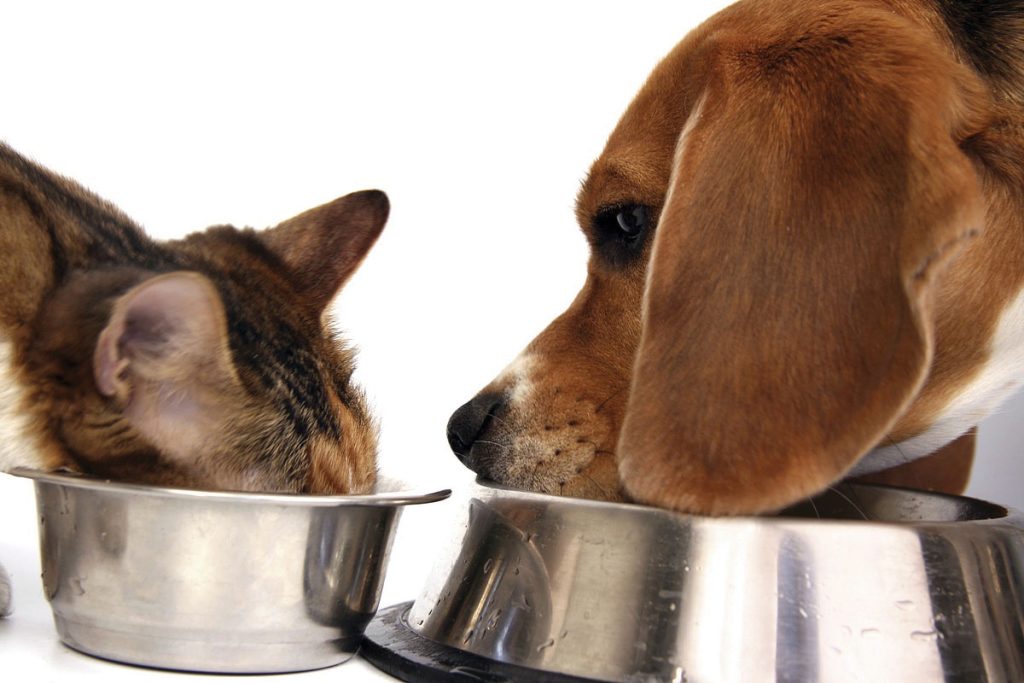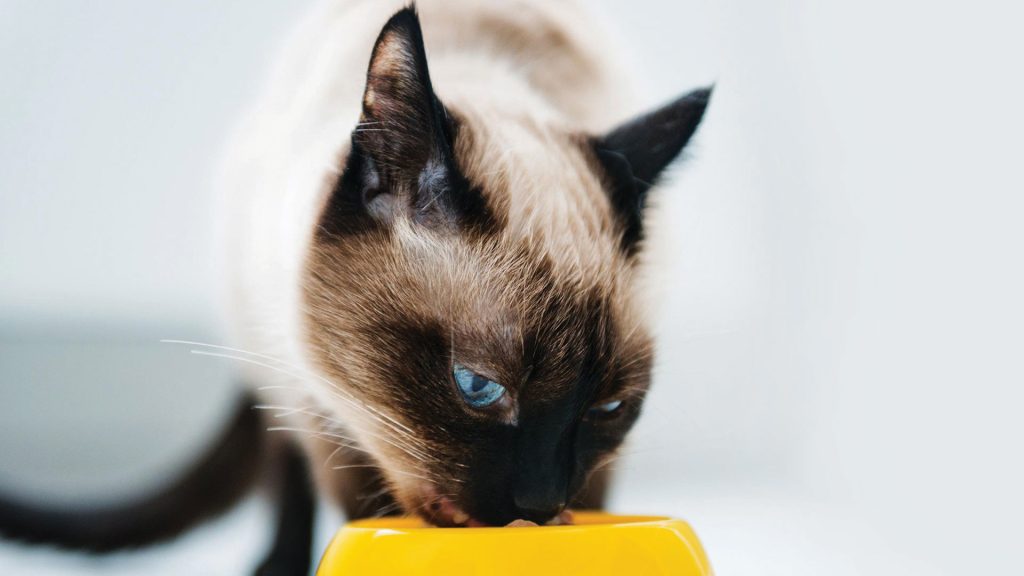THE HEALTH BENEFITS OF FEEDING YOUR PET A WHOLE FOOD DIET
by dr. patrick mahaney, vmd, cva, cvj

The “You are what you eat” perspective your parents forced upon you as a child also applies to your pets. Age, medications, ailments affecting the digestive tract and other body systems and various additional factors can alter a pet’s appetite and ability to digest food, as well as absorb nutrients. Such is why, owners must be proactive in ensuring the meals entering our pets’ mouths contain ingredients that are highly bioavailable (easily absorbed) so nutrients can be readily utilized to fight disease, reduce inflammation, resolve infection and service the body in other beneficial ways.
Generally, my canine and feline patients who eat whole-food diets throughout their lives have fewer health problems, need fewer trips to the veterinarian and better tolerate medications digestively than those eating processed pet foods. My mission to improve pet health through nutrition, is a driving factor in my holistic veterinary practice, which is why I’m sharing my comparison of whole versus processed-food feeding for pets.
What are the Differences Between Processed and Whole Foods?
Commercially-available kibble and many canned pet diets undergo significant alteration to achieve the final product and are thereby considered “processed foods.” Processed foods contain fractionated ingredients like meat and grain “meals and by-products,” which, either don’t exist in nature or are radically changed from nature’s format.
Conversely, whole foods appear identical or very similar to their natural form and contain vitamins, minerals, carbohydrates, proteins, fats and other substances that are utilized best by the body when consumed together. By breaking nutrients apart, food’s synergistic qualities can be lost. Co-factors essential for digestion may be deficient and can lead to poor absorption of nutrients and digestive tract upset (inappetence, vomit, diarrhea, flatulence, etc.).
Synthetic vitamins may not be efficiently absorbed as natural vitamins that are found in whole foods due to improper binding with digestive tract receptors (see visual examples in Good Food/Bad Food: A Little Book of Common Sense Nutrition). Additionally, synthetic vitamins may even be recognized as foreign and eliminated in a manner that creates free radicals that are harmful to internal organs.
Natural, whole-food vitamins are generally better absorbed as a result of improved binding with digestive tract receptors and aren’t eliminated in a manner that creates additional stress on the body like their synthetic counterparts.

Is Kibble Considered Whole Food?
No, kibble is not considered to be whole food. Kibble is produced through a moisture-depleting, cooking process called extrusion, which denatures proteins and deactivates enzymes essential to the digestive process. After being high-heat cooked, kibble is sprayed with rendered fat to improve palatability and can also be artificially colored.
Digesting kibble requires the secretion of gastric acid and pancreatic enzymes in addition to consumption of water. Kibble is commonly associated with gastric dilatation volvulus (GDV or “bloat”) in dogs and vomiting in cats, as many pets swallow their food whole without properly chewing.
Many types of kibble and some canned foods have caramel color added to create the appearance of real meat. Caramel color has come under fire as a toxic food additive as it contains 4-methylimidazole (4-MIE), a known animal carcinogen. Studies have found long-term exposure to 4-MIE caused lung cancer in mice, so it’s been added to California’s list of “Chemicals Known to the State to Cause Cancer or Reproductive Toxicity.”
Owners that choose to feed a diet with ingredients having been radically modified from nature’s version and added color to replicate real meat owners may be unknowingly predisposing their beloved canine and feline companions to developing cancer. Ultimately, dogs and cats don’t care about the color of their foods or treats. The aroma and flavor, yes.

Are Canned Foods Considered To Be Whole Foods?
Canned or moist food, has water as the primary ingredient, some may even contain real pieces of meat, vegetables, fruit, and whole grains. These options are better choices for pet owners seeking to feed a whole-food diet than canned foods appearing smooth and ‘pate-like’ and lack chunks of whole-food ingredients.
Yet, some canned foods have chunks of simulated meat which are actually conglomerations of meat and/or meat and grain “meals and by-products.” When examined in cross section, the difference can be discerned.
Many canned or moist foods are kept congealed or having a glistening appearance with stabilizing agents like guar or xanthan gum or carageenan.
Guar gum is a polysaccharide (complex carbohydrate) product made from ground guar beans and is linked to digestive tract upset, including soft stools and gas-induced bloating.
Xanthan gum is a polysaccharide formed by xanthomonas campestris bacteria fermentation, which is reputed to be indigestible and similarily with guar gum, can cause digestive tract upset.
Carageenan is a red algae-derived polysaccharide that according to the International Agency for Research on Cancer (IRAC) shows “sufficient evidence for the carcinogenicity of degraded carrageenan in animals to regard it as posing a carcinogenic risk to humans.” Like guar and xanthan gum, it’s also correlated with digestive tract upset.
If you were making home-prepared pet food, you would not add guar or xanthan gum or carageenan to create a smooth and shiny appearance. You’d just use basic, whole-food ingredients, perhaps slightly warm the food to release aroma, then feed it to your pet.

So, What Whole Foods Should I Feed My Pet?
Feeding fresh, moist, human-grade meals is my recommendation, over feeding processed foods to pets during times of illness and wellness. After all, nature makes food and then man makes pet food, which often contains ingredients that have been deemed unfit for human consumption.
Fortunately, there are many commercially-available options available to pet owners that can be purchased in pet or grocery stores, or ordered on-line. Some are cooked diets that are as simple as defrost and serve, while others require hydration and possibly the addition of a protein source like chicken, beef, fish or other.
Owners can also make a home-prepared diet for their pets. Though, home prepared diets may not be 100 percent nutritionally complete and balanced without instruction of food preparation. So that the food contains appropriate ratios of proteins, carbohydrates, fats, fiber, vitamins, and minerals necessary to meet canine or feline nutritional needs, owners can partner with their veterinarian to pursue a consultation with a university’s Veterinary Nutrition Support Service (University of California Davis and University of Tennessee are excellent options) or use a service like Balance IT.

There are many pet-appropriate human foods that can be served as treats or used as meal-formulating components, including:
• Vegetables: Beet, broccoli, carrot, cauliflower, mushroom, spinach, sweet potato, ripe tomato, and others can be fed raw or steamed and finely chopped or pureed and added to any food. Any vegetable that you would cook before eating (beets, sweet potatoes, etc.) should also be cooked when served to your pet. Vegetables having skins should have the skins, especially any areas of discoloration or “eyes” (like on sweet potatoes), removed before serving.
• Fruits: Apple, banana, blackberry, blueberry, cantaloupe, cherry, melon, pear, raspberry, watermelon and others not only are tasty, but they also provide essential moisture,
fiber, minerals and vitamins.
NOTE: Vegetables and fruits should be washed before serving. If available, always choose an organic option to cut down on potential pesticide exposure.
• Meats: Cooked, de-fatted, low-sodium proteins like chicken, turkey, beef, lamb and fish are great options to use as the basis of home-prepared meals. Raw-meat diets are more likely to potentially sicken pets and people should they contain pathogenic bacteria like Salmonella, E. coli, Listeria and others. A chart of Safe Minimum Cooking Temperatures with recommendations to cook meat to 140-165 F (depending on the type of meat) to kill bacteria is available at foodsafety.gov. Additionally, U.S. sourced meat jerky lacking chemical preservatives and flavor enhancements and or tuna water or meat-broth cubes can be given as snacks.
NOTE: Before feeding your pet any human foods besides those mentioned above, reference the ASPCA’s People Foods to Avoid Feeding Your Pets.
My dog Cardiff exclusively eats a whole-food based diet and treats from The Honest Kitchen and Lucky Dog Cuisine and my human foods since he was a puppy. Besides surviving immune-mediated (“auto-immune”) hemolytic anemia four times and developing T-Cell Lymphoma twice, both of which lack correlation to his diet, he’s been incredibly healthy. His whole-food feeding plan helps reduce the potential digestive tract side effects associated with the medications required to manage both ailments and he continues to thrive into his senior years.
Consult with your veterinarian about whole-food feeding options for your pet. If your veterinarian recommends kibble over whole foods, then seek the advice of a holistic veterinarian by locating one in your area via ahvma.org.
Top Five Toxins to Look for in Your Pet’s Foods and Treats
Other ingredients that could be in your pet’s food or treats that should be avoided:
- Butylated Hydroxyanisole (BHA) and Butylated Hydroxytoluene (BHT): BHA and BHT are chemical preservatives added to oils (fats) that can be found in pet foods and treats. BHA is included in California’s Office of Environmental Health Hazard Assessment list of Known Carcinogens and Reproductive Toxicants. The National Institute of Health (NIH) reports that “dietary exposure to BHA caused benign and malignant tumors of the forestomach (papilloma and squamous-cell carcinoma) in rats of both sexes and in male mice and hamsters (IARC 1986, Masui et al. 1986)”. BHT also a known carcinogen and causes kidney and liver damage in rats and has been banned as a human-food preservative in Australia, Japan, Romania, and Sweden. Natural preservatives like Vitamins C or E or foods and treats having no preservatives are safer options than edibles containing BHA and BHT.
- Ethoxyquin: Ethoxyquin is a chemical preservative to prevent fat spoilage which is illegal to use in human foods in the United States, yet it can still legally be added to pet foods and treats. Protein “meals,” like fish meal, are food additives which may contain Ethoxyquin. Human safety data reports Ethoxyquin to be harmful when swallowed or comes into direct contact with skin.
- Artificial Colors: Besides the aforementioned caramel color which contains 4-methylimidazole (4-MIE), some pet foods and treats contain Blue 2, Red 40, and Yellow 5 and 6 which can contribute to hypersensitivity (allergic-type) reactions, behavior problems, and cancer in humans.
- Meat and Bone Meal: Meat and bone meal can contain pentobarbital, a barbiturate anesthetic used to euthanize animals (confirmed through FDA testing of dog foods in 1998 and 2000) and is one a pet-food ingredient having higher likelihood to contain heavy metals.
- Propylene Glycol: Propylene Glycol (PG) is a humectant (moistening agent) found in some soft dog treats (simulated meat versions) and dry dog foods having a crumbly texture. PG is a chemical derivative of ethylene glycol (EG = antifreeze), which only requires small volumes to be consumed to cause life-threatening toxicity by damaging the kidneys. Although PG is touted to be non-toxic, tasteless, and non-absorbed by your dog, it damages cat red blood cells and the FDA has banned its inclusion in feline foods and treats. Additionally, frequent ingestion of PG won’t improve a dog’s overall health, which can often be bettered by having food be naturally moist or by adding filtered water, low-sodium broth, or other safe hydration source.

Follow Patrick Mahaney VMD, CVA, CVJ (Veterinarian, Certified Veterinary Acupuncturist, and Certified Veterinary Journalist) on Twitter @PatrickMahaney, on facebook at facebook.com/PatrickMahaneyVeterinarian, on Instagram at instagram.com/patrickmahaney, or catch his many YouTube videos at youtube.com/user/patrickmahaney.
You can also subscribe to an emailed version of Dr. Mahaney’s veterinary blog on his website, California Pet Acupuncture and Wellness (CPAW), Inc. at patrickmahaney.com.
.